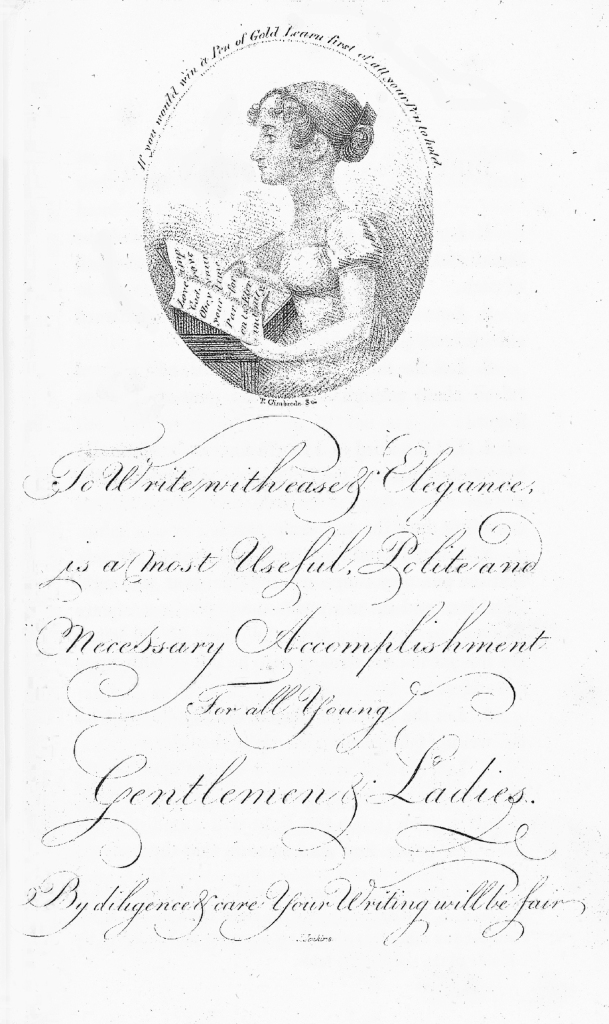
The first Accomplishment I want to acquire is writing- an authentic regency writing hand. After all, The Polite Lady warns me “But it is not only an useful it is likewise a polite qualification; nor should any one pretend to the character of an accomplished woman who cannot write a distinct and legible hand.”
The handwriting I’ve seen in Jane Austen’s letters and manuscripts, as well as that of her contemporaries, is not always distinct or legible. But each letter usually slants exactly the same way, and there are enough commonalities among very different people that they must have been trained to follow similar models. How can I find those models? A book titled Young Man’s Best Companion and Guide to Useful Knowledge (There was a stiff competition for ‘Best Companion’, it seems, based on the number of books that use some variation of this title) tells me to carefully copy good examples of handwriting, and that:
In selecting examples for imitation, engraved specimens are to be preferred to written : for the engraver working deliberately and mechanically with his tools, and re touching the plate until his work be to his satisfaction, is able to produce letters, words, and lines, much more regular and uniform in shape and proportion than any which, unless the writer be singularly accomplished indeed, can be executed by the hand and pen.
This seems like good advice, but how am I going to find the right engraved specimens? What do I search for, since my period sources do’t give me specific names? I had heard of “Copperplate” and “Spencerian” handwriting styles, but they belong to the later 19th century. To achieve their graceful thick-and-thin lines, calligraphers use flexible steel nibs that only replaced quill pens in the 1830s or so. I discovered that what is now called English Roundhand, an ancestor of Copperplate handwriting developed in the 17th century, was popular through the early 19th century. It also accords well with my sources, which often mention a “round” hand in contrast to “running” or “Italic” hands.
As for engraved specimens, George Bickham‘s name comes up again and again. In The Universal Penman, he collected fine examples from the best English writing masters and published them as engraved plates. More relevant to my needs is his slim volume The Young Clerk’s Assistant; or Penmanship made easy, instructive, and Entertaining, first published in 1733. Google Books has a full text of a 1787 edition, It contains examples of round and other hands, and LOTS of “moral maxims” to practice copying. The title may sound rather masculine, but there are poems and epigrams specifically aimed at young ladies as well as young gentlemen.
Unfortunately, Google Books’ scan is too washed out to be a good model- it doesn’t capture the fine hairlines that are an essential part of the letter forms. I acquired Dover’s reprint of the 1733 edition, only to find that it doesn’t include my favorite plates titled “To learn round Hand without a Master”, which had large letters both separately and joined. They instructs me to “Write each article on this and the following page forty times over in a Copy-Book ruled with double lines.” Here they are from that washed out scan of the 1787 edition (Click to see a larger):
Since The Young Man’s Best Companion told me to practice writing each character large and carefully, I felt I needed to look further for models. I found it in John Jenkins’ Art of Writing, an American manual from 1813. The International Association of Master Penmen, Engrossers, and Teachers of Handwriting (IAMPETH) hosts high-quality scans of some hard to find writing manuals, and Jenkins’ book is the earliest they have. The paper it’s printed on is russet with age, but the hairlines stand out clearly! I de-colored and cleaned up a few of the plates that show the basic strokes and the small letters:
John Jenkins is a big believer in teaching through “dialogue,” by which he means memorized questions and answers about the theory and practice of writing. I don’t find that very helpful, but I do like his method of presenting the basic pen strokes that form all the letters. The hardest elements for me to get right are the slope of the letters and the delicate hairline curve at the top and bottom of many lines, and his basic strokes emphasize learning those skills. A close comparison of his letterforms with Bickham’s shows that they are not identical, but they are definitely in the same family.
Jenkins also has the ladies in mind in his volume, as this elegant page shows:

To Write with ease & Elegance / is a most Useful, Polite and / Necessary Accomplishment / For all Young / Gentlemen and Ladies. / By diligence and care Your Writing will be fair




What fantastic research! I stumbled across your blog while doing research for my museum’s “Accomplishment Bootcamp”, a hands-on camp for kids where we focus on what it meant to be accomplished in the Federal Era. Very much looking forward to keeping up with your posts!
LikeLike
Accomplishment Bootcamp- that sounds like a lot of fun! I hope you find some of my research helpful- make sure you check out the “Sources” page for my ever-growing bibliography.
LikeLike
So excited to find your blog! I’m wanting to learn roundhand myself and have been trying to figure out where to start. I also love Jane Austen, so this is awesome!
LikeLike
Hooray! I’m glad you found my blog too! I hope you find helpful information here. I’m afraid some of the links on this post are already broken, but I’ve tried to keep my “Sources” page up-to-date with new links as they change. Let me know if you have any questions!
LikeLike